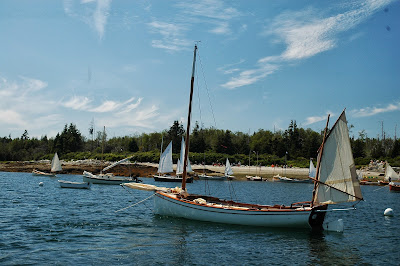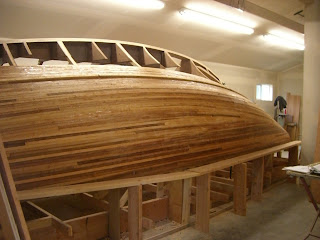 |
Summit 35
Nice Profile |
One of the best things about being in the market for a new boat is checking out the newest designs, going for test sails and pondering cruising to distant places or collecting trophies. When I started looking at the Summit 35, I quickly forgot about the distant coves and palm trees, and instead, thought about racing and collecting pickle dishes.
Mark Mills designed it for Summit Yachts and Edgewater Boats builds it in Florida. The Summit 35 is really a buoy racer with enough accommodations for a couple to spend a week or so cruising, or for longer coastal races. Mills describes the boat as being designed to excel under the IRC. The IRC is a handicapping rule that is in some ways like PHRF and some ways like other measurement rules such as the now defunct IOR rule. I say that because to get a rating you must have your boat measured or have the builder certify the dimensions of the boat. Then you submit all the required information to the Rating Authority, which has a secret formula that they use to calculate the boats handicap rating. The PHRF aspect comes from the fact that the Rating Authority may use subjective judgments as well as the boats measurements to give a boat a final rating. The idea behind the secrecy of the rating formula is that designers and builders aren’t supposed to know what it is and therefore can’t tweak their designs to take advantage of the rule. Some of you may recall the goofy designs that came out of the IOR rule, where speed producing factors were penalized and credit was given for speed reducing factors.
 |
| The S-35 has a displacement of 10,930 lb with 5,300 lb of ballast, most of which is in that massive bulb. |
Enough of the handicapping jargon…Let’s just evaluate the Summit 35 based on common sense. I should say out front that I haven’t had an opportunity to sail one yet and all the information I have on the boat was taken from Summit-yachts.com and yachtworld.com. I like the overall proportions of this boat. The very slightly raked stem and transom make the hull more visually attractive than if they were vertical, as does the slightly sprung sheer. Below the waterline we see a fairly shallow hull with a narrow waterline beam and lots of flare in the topsides. The keel consists of a vertical fin with a slightly raked leading edge coupled to a massive lead bulb. Notice in the photo that the bulb extends a long way forward from the fin. There doesn’t appear to be a kelp cutter on the keel so that bulb could be a problem in areas with lots of kelp, like southern California. On the other hand, the bulb will keep the boat on its feet in a breeze.
 |
| Big cockpit, square corners and German mainsheet system |
I like the deck on this boat. It has a beautiful cabin trunk and a nice big cockpit with seats forward and plenty of room for the crew. The options list includes twin wheels instead of the standard tiller. I would choose that option in spite of the extra weight and cost. The wheels are smallish, but allow the helmsperson to sit well outboard, and leave plenty of room for the crew. Notice that the main traveler is located well aft on the cockpit floor, with the sheet led forward along the boom, then down under the deck and back to a pair of winches just aft of the short cockpit coamings. This arrangement is known as a ‘German’ or ‘Admirals Cup’ system. With 2:1 purchase and the ability to trim the main quickly, it can be an excellent arrangement for a racer, and has some benefits for the cruising yachtsman who understands the strengths and weaknesses of this system. On the Summit 35 with tiller steering, the helmsperson sits forward of the main trimmer, on or outboard of the coaming, with the main trimmer sitting aft. It doesn’t look too comfortable for the helmsman. With wheel steering, the helmsman will be aft of the main trimmer, but it’ll be a tight fit for the trimmer. This will be fine on the upwind legs, but could get complicated on the downwind legs jibing in heavy air and at the leeward mark where the main trimmer will be ripping in the mainsheet and the helmsman is busy getting around the mark and avoiding flying elbows and mainsheet tail. It’s not a big deal, but will take some practice for the helmsman and trimmer to work out how to do their jobs without getting in each other’s way.
In studying the cockpit, notice that everything is pretty well squared off and all the edges and corners have roughly the same radius. There is nothing wrong with this and it is quick to tool straight lines and squared edges, but this very nice looking overall deck design could have been more artfully sculpted. Of course boats have a way of getting prettier if they win a lot of races, and I have no doubt that the Summit 35 will do that.
 |
| Compact galley is suitable for sandwiches and MREs |
It’s hard to fault the interior of this boat. The layout is just about perfect, with a good sized galley and nav station as well as a positively luxurious head for a boat this size. The interior drawing shows a big dropleaf table in the main cabin, but Im sure few Summit 35’s will sail with it, as it looks heavy and takes up space needed for packing chutes. The galley is fitted with a gimbaled Origo two-burner alcohol stove. This is a very good unit that eliminates the need for a gas bottle and its attendant locker, solenoid, etc. While the galley is too small for cruising, it’s quite adequate for the racing crew that expects sandwiches and MRE’s instead of ‘meals’.
I was surprised to see that the Summit 35 is equipped with an aluminum mast instead of carbon fiber. This may be due as much to the IRC rule as to economic considerations. The boat carries non-overlapping headsails and can be fitted with symmetrical or asymmetrical spinnakers. There are some advantages to symmetrical spinnakers in tactical situations, especially at the leeward mark, but these are outweighed by the simplicity and efficiency of asymmetrical kites. Unless you plan to race your boat under IRC rules, which apparently favors symmetricals, you’ll want to set your Summit 35 up with a short bowsprit and asymmetrical kites.
If I were in the market for a racer, I’d consider the Summit 35. It’s a nice looking and fast boat with reasonable accommodations and, inspired by Barry Carroll, a good pedigree. I like the fact that it’s built here in America. I think that, regardless of whether the IRC rule really gains much traction in the USA, the S-35 will be a very effective PHRF racer as well. Its interesting to compare this boat to the J-111. Its very close, but I think I like the J just a little bit more. Of course neither is well suited for the kind of cruising were planning, but it would be interesting to see these boats matched against each other in a buoy race and in a long distance race.
Inasmuch as were in the market for a used cruising boat, my next review will be the Beneteau 423. In the meantime I invite you to visit www.summit-yachts.com if youd like to learn more about the S-35.














































